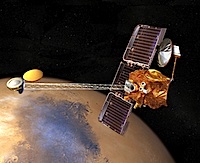 The
THEMIS Team Release of JMARS is available to THEMIS science team members for use in planning observations and
analyzing THEMIS data. In addition to the standard layers available in the Public Release, it includes the THEMIS ROI
Layer and the THEMIS Planning Layer. The THEMIS Team Release also gives science team members access to THEMIS data
that has not yet been officially released to the Planetary Data System (PDS).
The
THEMIS Team Release of JMARS is available to THEMIS science team members for use in planning observations and
analyzing THEMIS data. In addition to the standard layers available in the Public Release, it includes the THEMIS ROI
Layer and the THEMIS Planning Layer. The THEMIS Team Release also gives science team members access to THEMIS data
that has not yet been officially released to the Planetary Data System (PDS).
Once new team members have registered for a THEMIS Team account, they can log into the JMARS website and download the THEMIS Team Release.
What can JMARS do for me?
Mission planners
- Plan IR and VIS observations for the THEMIS camera.
- View "Regions of Interest" (ROIs) submitted by THEMIS science team members.
- Locate previously acquired observations.
Planetary geologists
- Simultaneously overlay and view datasets from TES, THEMIS, and other Mars-orbiting instruments.
- Submit "Regions of Interest" (ROIs) over areas where you would like the missions planners to collect data.
- Determine the extent and quality of observational coverage for a particular area.
- Access THEMIS data that has not yet been released to PDS.
Get a JMARS account
- Begin by registering for a public account.
- Before downloading JMARS, go to: http://jmars.asu.edu/user/register to register for an account.
- Fill out the registration form. A confirmation email will be sent to the email address you provide.
- Follow the link in the confirmation email to activate your account.
- At this point you have a Public account. You now need to apply for "THEMIS team"
status.
- Go to: http://jmars.asu.edu/user and log into the JMARS website. Then click on the "My Account" link at the top of the page.
- Click the "Apply for Role" tab at the top of the page, choose on the "THEMIS Team" option and click "Apply".
Your THEMIS Team member status will be activated as soon as your participation on the THEMIS Team has been
confirmed.
- Once you have THEMIS Team member status, whenever you log into http://jmars.asu.edu the website will automatically give you team member access.
- To edit your account, go to: http://jmars.asu.edu/user , log into the website and click on the "My Account" tab.
Download and install JMARS
- Internal Users
- If you are planning to use JMARS in the Mars Space Flight Facility building, it is available on all Linux machines.
- External Users
- Go to http://jmars.asu.edu site and log in.
- The "Download JMARS" section on the right-hand side should say "THEMIS Team Version". If not, you either did not log in properly or do not yet have THEMIS Team member status.
- The JMARS team recommends the Cross-Platform WebStart Installer because it always has the latest version and works with all operating systems.
Starting JMARS
- Internal Users
- Open a terminal window and type:
> jmars
- External Users
- On most operating systems, the installer will place an icon on your desktop. You can start JMARS by double-clicking the icon and entering your username and password.
- To manually launch JMARS on a Linux machine, change to the directory containing the jmars.jar file (which you have already downloaded) and type:
- If you would like to open JMARS from a different directory, just replace "jmars.jar" with "path/jmars.jar".
> java -jar jmars.jar
Starting JMARS with additional arguments
The startup behavior of JMARS can be modified by including additional command-line arguments. (Note: Only one of these command-line arguments can be used at a time.)
- Specify the Starting Position
By default, JMARS starts with the viewing window centered at 0E, 0N. This starting location can be changed by adding latitude and longitude arguments to the jmars command.
> jmars Longitude Latitude
- Longitude - the value is assumed to be East longitude unless a "W" is used after the numerical value. (e.g., 120W)
- Latitude - the value is assumed to be North latitude unless a "S" is used after the numerical value. (e.g., 120S)
- Starting with Session Files
Session files allow users to restart JMARS in a previously saved configuration by specifying a startup file. See the Session Files page for more information.
> jmars path/session_file_name.jmars
Starting JMARS with flags
The startup behavior of JMARS can also be modified by including any of the following command line flags. Unlike the command-line arguments described above, multiple command-line flags can be used at one time, and they can be used in conjunction with command-line arguments.
- Clean: The "clean" flag will clear out the map tile cache before startup.
- Slideshow: The "slideshow" flag will enable the JMARS slideshow mode. See the Slideshow Mode page for more information
- Version: The "-version" flag (with lower case v) will list some information about the JMARS version being used. The "-Version" (with upper case V) flag will list much more detailed information about the JMARS version being used.
- Help: The "-help" flag will list the available command-line arguments and flags in the terminal window.
> jmars clean
> jmars slideshow
> jmars -version
> jmars -Version
> jmars -help



